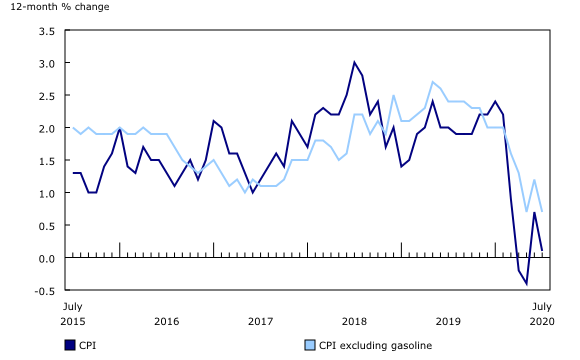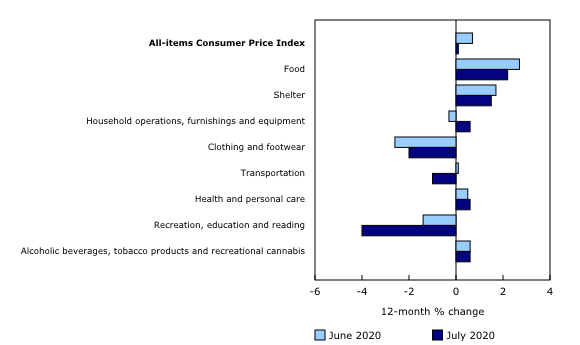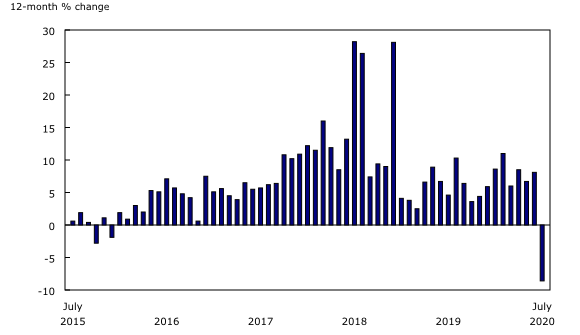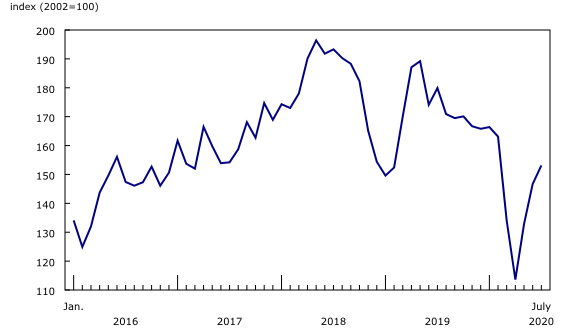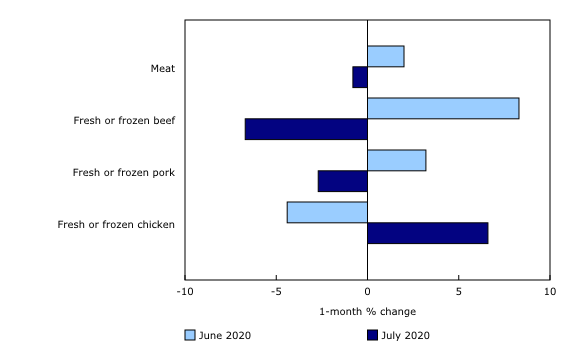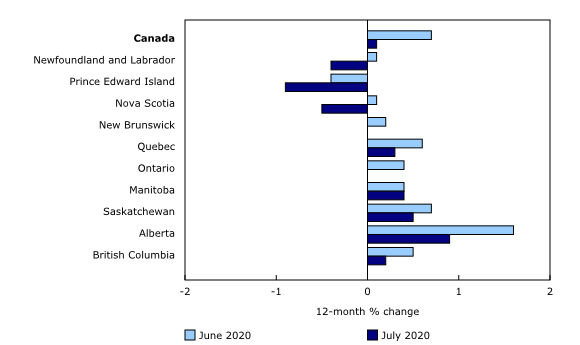Consumer Price Index, July 2020
Archived Content
Information identified as archived is provided for reference, research or recordkeeping purposes. It is not subject to the Government of Canada Web Standards and has not been altered or updated since it was archived. Please "contact us" to request a format other than those available.
Released: 2020-08-19
July 2020
0.1% 
(12-month change)
The Consumer Price Index (CPI) rose 0.1% on a year-over-year basis in July, down from a 0.7% increase in June. Excluding gasoline, the CPI rose 0.7%.
On a seasonally adjusted monthly basis, the CPI fell 0.1% in July.
Highlights
Prices rose in five of the eight major components on a year-over-year basis in July. The CPI grew at a slower pace than in June as a result of a broad-based slowdown in price growth, spanning both goods and services. Growth slowed the most in the transportation component, mostly due to the air transportation index.
Prices fall for air transportation and traveller accommodation
In July, air transportation prices (-8.6%) fell for the first time on a year-over-year basis since December 2015, when prices declined amid low prices for crude oil and airline fuel. Although many flights remained cancelled or suspended as a result of the COVID-19 pandemic, airlines were offering various incentives such as reduced fees, discounts and promotions to encourage a return to travel. Prices for traveller accommodation fell 27.0% year over year, posting record declines for the third consecutive month.
Fifth consecutive year-over-year decline in gasoline prices
Gasoline prices fell 14.9% on a year-over-year basis in July, following a 15.7% decline in June. Although gasoline prices rose 4.4% on a monthly basis amid the reopening of many businesses and services, crude oil prices increased minimally in July due to concerns that surging coronavirus infections around the world could jeopardize a recovery in fuel demand. This followed several months of volatile monthly price movements related to changes in demand for gasoline during the COVID-19 pandemic.
Meat prices increase at a slower pace
Meat prices rose at a slower pace, year over year, in July (+4.8%) than in June (+8.1%). This was partly attributable to lower month-over-month prices for fresh or frozen beef in July (-6.7%), following a significant increase in June (+8.3%). The decrease in beef prices marked the largest monthly decline since August 2003. Beef prices fell as production increased, gradually returning to pre-COVID-19 production levels.
The index for fresh or frozen pork fell 2.7% month over month following a 3.2% increase in June as pork production recovered, despite initially being less affected than beef production by plant closures.
Fresh or frozen chicken prices rose 6.6% on a monthly basis following a 4.4% decline in June, the largest monthly decline since November 2004. Chicken prices rebounded, coinciding with strong demand and lower production, as well as summer-related seasonality.
The monthly price movements for both beef and chicken were most pronounced in the Western Canadian provinces.
Prices for multipurpose digital devices decline year over year
The price index for multipurpose digital devices fell 29.7% compared with July 2019, when subsidies for wireless devices were reduced following the widespread introduction of unlimited data plans, shifting more of the cost of devices to consumers. Since then, however, consumers have paid less for multipurpose digital devices during the past year, due in part to industry-wide promotional pricing aimed at clearing inventories prior to the release of new smartphone models.
Regional highlights
Prices rose in five provinces on a year-over-year basis in July. Year-over-year price declines were observed in three of the four Atlantic provinces, where furnace fuel oil is more commonly used. Fuel oil and other fuels (-20.6%) are subject to similar oil price dynamics as gasoline, and prices remained low compared with July 2019.
Lower prices for homeowners' home and mortgage insurance in Manitoba
Homeowners' home and mortgage insurance costs fell 6.4% in Manitoba compared with June, the largest monthly decline on record, mostly attributable to Retail Sales Tax (RST) exemption. Effective July 1, the provincial government eliminated the RST on tenants, mortgage and homeowners' insurance.
Two ways of exploring the Consumer Price Index (CPI)
Visit the Consumer price index portal to find all CPI data, publications, interactive tools, and announcements highlighting new products and upcoming changes to the CPI in one convenient location.
Check out the Consumer Price Index Data Visualization Tool to access current and historical CPI data in a customizable visual format.
Additional research related to COVID-19
For more information about the impact of COVID-19 on the CPI, please consult the research document entitled "Consumer expenditures during COVID-19: An exploratory analysis of the effects of changing consumption patterns on consumer price indexes," released on July 13, which explores new sources of expenditure data to estimate basket weights that reflect shifting consumption patterns during the pandemic.
For more information on consumer expenditures during COVID-19, users can consult two available documents. The first is "Canadian Consumers Prepare for COVID-19," released on April 8, which examines the shifting consumption patterns of Canadians during the COVID-19 pandemic up to March 14. The second is "Canadian Consumers Adapt to COVID-19: A Look at Canadian Grocery Sales up to April 11," released on May 11, which explores a continued shift in the consumption patterns of Canadians during the COVID-19 pandemic up to April 11.
All of the above publications can be found in the Prices Analytical Series (62F0014M).
Note to readers
COVID-19 and the Consumer Price Index
Statistics Canada continues to monitor the impacts of the novel coronavirus (also known as COVID-19) on Canada's Consumer Price Index (CPI).
In July, measures remained in place across much of the country to restrict gatherings and the movement of people. In-person field collection continued to be conducted via telephone or Internet for health and safety reasons, supplementing prices collected via web scraping, transaction data and administrative data. Due to the impact of COVID-19 on product availability in the month of July 2020, select sub-components of the CPI received temporary special imputations.
Some products and services, such as personal care services, that were unavailable for consumption in previous months were available for consumption in July, while others, such as travel tours, remained unavailable. Availability of goods and services varied throughout the country, as different provinces reopened to various extents at different times. The following sub-indexes were imputed from the monthly change in the All-items index: travel tours, components of spectator entertainment, and use of some recreational facilities. These imputations have the effect of removing the impact of these goods and services from the CPI.
Consistent with previous months affected by the COVID-19 pandemic, prices for suspended flights are excluded from the July CPI calculation because passengers were ultimately unable to consume them. As a result, select sub-components of the air transportation index were imputed from the parent index.
Where prices were missing due to high levels of out-of-stock products or the temporary closure of businesses, they were imputed with the average price movement of available prices for those items.
A document entitled Technical Supplement for the July 2020 Consumer Price Index is available in the Prices Analytical Series (62F0014M) publication, with further details on the imputations used to compile the July 2020 CPI.
Cellular services index
The cellular services index is available upon request. For more information, contact us (toll-free 1-800-263-1136; 514-283-8300; STATCAN.infostats-infostats.STATCAN@canada.ca).
Real-time data tables
Real-time data table 18-10-0259-01 will be updated on August 31.
Next release
The Consumer Price Index for August will be released on September 16.
Products
The Consumer Price Index Data Visualization Tool is available on the Statistics Canada website.
More information about the concepts and use of the Consumer Price Index (CPI) is available in The Canadian Consumer Price Index Reference Paper (62-553-X).
For information on the history of the CPI in Canada, consult the publication Exploring the First Century of Canada's Consumer Price Index (62-604-X).
Two videos, "An Overview of Canada's Consumer Price Index (CPI)" and "The Consumer Price Index and Your Experience of Price Change," are available on Statistics Canada's YouTube channel.
Contact information
For more information, or to enquire about the concepts, methods or data quality of this release, contact us (toll-free 1-800-263-1136; 514-283-8300; STATCAN.infostats-infostats.STATCAN@canada.ca) or Media Relations (613-951-4636; STATCAN.mediahotline-ligneinfomedias.STATCAN@canada.ca).
- Date modified:


